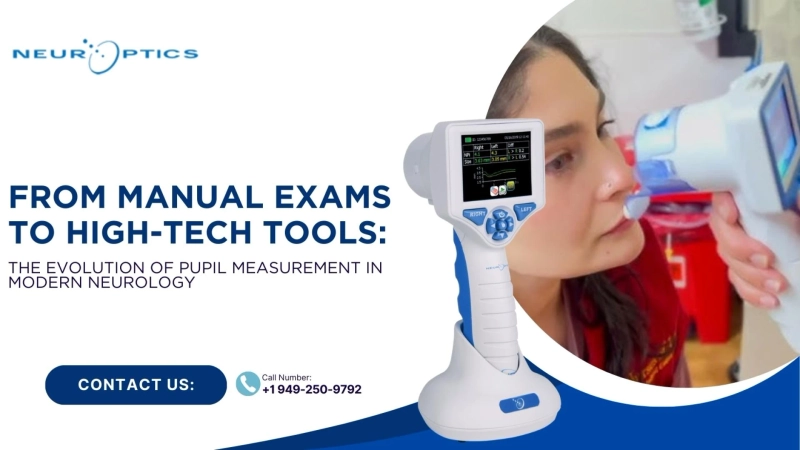Neurology’s seen some serious upgrades, especially when it comes to pupil assessment. Gone are the days of just flashing a penlight and hoping you caught the right reaction. Now, with advanced tech, clinicians get real-time, precise measurements, no more guesswork. This shift isn’t just for show; it means neurologists make faster calls with way more confidence, which straight-up benefits patient care. In this post, we’ll break down how we moved from basic manual tests to cutting-edge tools, and why this evolution is a big deal for modern neurology.
Introduction
For many years, neurologists have relied on the eyes for the diagnosis and evaluation of brain function. Although pupil responses provide critical clues about neuronal status from acute brain injury to more global systemic diseases, the first line of assessment, the penlight exam, suffered from many drawbacks and, unfortunately, shortcomings in accuracy and consistency for decades. The assessment of pupil size and reactivity remained in the realm of subjective interpretation by the examiner and dependent on the examiner's technique, and overall depended both on their subjectivity and technique.
The use of modern technology has fundamentally changed the assessment of pupil size. The data provided from modern devices that objectively measure pupil size is accurate, high-quality, reproducible, and has taken away the majority of guesswork, if even applied. The pupilometer allows clinical practitioners to assess even small changes in pupil response, changes that may not be easily detected with the penlight exam. This now becomes something that can improve the accuracy and consistency of the quality of the assessment in neurology.
The Traditional Approach: Manual Exams
Historically, neuro exams were pretty much a mix of basic equipment and the clinician’s eye, literally. You’d get a flashlight, check for pupil size, reactivity, and symmetry, and hope your assessment was on point. The problem? It was way too subjective. Estimating changes in pupil diameter by sight alone? That’s a recipe for inconsistency. Even minor shifts could go unnoticed, especially since different clinicians might see different things. In critical care, where even tiny changes can flag serious neurological decline, that’s a huge risk. The whole thing was fast, sure, but not exactly foolproof.
The Shift to High-Tech Tools
The technological advancement has resulted in the creation of sophisticated devices such as the NPi pupillometer. In contrast to conventional manual examinations, this portable device gives objective, repeatable, and real-time pupillary size measurement responses.
The NPi, or Neurological Pupil index, normalizes pupil measurement with a score that indicates the degree to which a reaction is normal or abnormal. Examiners no longer have to predict, as actual measurable numerical values are provided and can be monitored over time. This facilitates the identification of early warning signs of neurological deterioration and enables more informed decisions in emergency and ICU settings.
Why Precision Matters in Pupil Measurement
Precise pupillary size measurement is more than just data collection; it’s about patient outcomes. In conditions such as traumatic brain injury, stroke, or cardiac arrest, even a minor percent change in pupil size can indicate serious complications.
By using advanced pupillometers, healthcare providers can:
● Decrease variability between different examiners.
● Detect abnormalities that may not be visible to the naked eye.
● Offer authentic data values for accurate record keeping and long-term monitoring.
● Support quicker interventions, which can save lives.
This shift from manual to high-tech tools ensures that every neuro exam is backed by objective evidence.
The Role of Neuroptics Technology
Current pupillometers, such as those designed by Neuroptics, represent the cutting edge of contemporary neurology. These machines are intended to be incorporated into clinical practices with ease, accelerating pupil examination, precision, and reliability.
By having the capability to record and review the NPi on multiple exams, critical care units and neurologists are able to monitor a patient's neurological status with unparalleled accuracy. This data-based methodology lifts the quality of care in hospitals globally.
FAQ Section
Q1: Why are manual pupil exams not sufficient anymore?
Manual exams are constrained by subjectivity and variability across examiners. High-tech devices guarantee precision, consistency, and improved detection of minute changes.
Q2: What is the Neurological Pupil index (NPi)?
The NPi is a standardized score derived from a pupillometer, and it's an objective measure of pupil reactivity to light.
Q3: How does the percent change in pupil size impact diagnosis?
Even minor changes in pupil size can signify neurological problems. Pupil size percent change measurement detects decline earlier.
Q4: Are high-tech pupillometers complicated to use?
No. Tools such as the NPi pupillometer are intended to be simple to use and easily incorporated into standard clinical routines.
Q5: Who gains most from advanced pupil measuring instruments?
Critically ill, neurological, and emergency department patients receive the greatest benefit, as timely and precise evaluations are critical in these environments.
Conclusion
The shift from manual exams to advanced technology in neurology is honestly a seismic upgrade. Previously, clinicians had to rely on subjective visual assessments, basically, shining a flashlight in someone’s eyes and hoping for the best. Now? Devices like the NPi pupillometer are in play, bringing in objective, repeatable measurements. No more guesswork. These instruments spit out precise data, letting clinicians catch even subtle abnormalities that might’ve slipped through the cracks before. Bottom line: these technological advancements are seriously enhancing diagnostic accuracy and patient care in neurology.
Ready to elevate your neurological assessments? Explore how Neuroptics’ advanced pupillometers can transform patient care with precision and reliability.


